Segmentation, Targeting and Positioning
Segmentation, Targeting and Positioning (STP) are the basic tools used by the marketers.
Each customer has different needs, wants and desires. Also, each customer has a different background, education level, and experiences. Hence companies need to look for the offerings that can match with the need of different groups of customers or segments.
- Segmentation: Dividing the heterogeneous market into homogeneous segments by using one or more attributes.
- Targeting: Deciding the number of segments of the market to pursue.
- Positioning: Creating a distinctive image of product/brand in the mind of consumers.
Positioning is not what you do to a product; it is what you do to the mind of a prospect. – Ries and Trout (1972)
Table of Content
- 1 Segmentation, Targeting and Positioning
- 2 Segmentation, Targeting and Positioning Process
- 3 What is Market Segmentation?
- 4 What is Targeting in Marketing?
- 5 What is Positioning?
- 6 Perceptual Mapping
- 7 Key Terms
- 8 Reference
- 9 Marketing Management Topics
Segmentation, Targeting and Positioning Process
The growing use of the Segmentation, Targeting and Positioning Process (STP) has occurred as a direct result of the prevalence of mature markets, the greater diversity in customer needs, and the ability to reach specialized or niche segments.
As such marketers are increasingly segmenting markets and identifying attractive segments (i.e. who to focus on and why?), in order to identify new product opportunities, develop suitable positioning and communications strategies (i.e. what message to communicate), and effectively allocate resources to key marketing activities (i.e. how much should we spend and where?).
STP refers to the three activities
- Segmentation
- Targeting
- Positioning
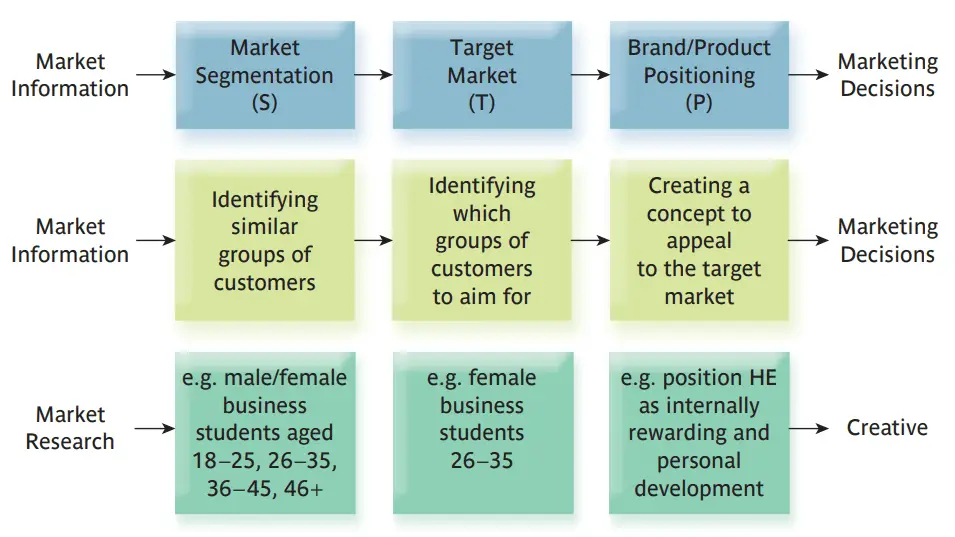
Benefits of Segmentation, Targeting and Positioning Process
Enhancing a company’s competitive position by providing direction and focus for marketing strategies such as targeted advertising, new product development, and brand differentiation.
For example, Coca-Cola identified through market research that its Diet Coke brand (also marketed as Coca-Cola Lite) was regarded as ‘girly’ and ‘feminine’ by male consumers. As a direct result the company developed a new product, branded Coke Zero, which is targeted at the health-conscious male segment of the soft drinks market.
Examining and identifying growth opportunities in the market through the identification of new customers, growth segments, or new product uses.
For example, Arm & Hammer was able to attract new customers when existing consumers identified new uses for their baking soda (Christensen, Cook, and Hall, 2005). Lucozade also changed the positioning and targeting from its original marketing strategy positioned for sick children and rebranded to target athletes as an energy drink.
More effective and efficient matching of company resources to targeted market segments promises the greatest return on marketing investment (ROMI).
For example, financial institutions like HSBC and Barclays and large retailing multinationals such as Tesco and ASDA Wal-Mart are utilizing data-informed segmentation strategies to effectively target direct marketing messages and rewards to customers they have classified as offering long-term value to the company, i.e. they are profitable customers.
What is Market Segmentation?
Market segmentation can be defined as the process of dividing a market into distinct subsets of consumers with common needs or characteristics and selecting one or more segments to target with a distinct marketing mix.
Characteristics of Market Segment
Before going into the segment identification process, student should first understand that not all segments are profitable. To be an effective target segment, it should posses following characteristics.
Characteristics of Segment should be:
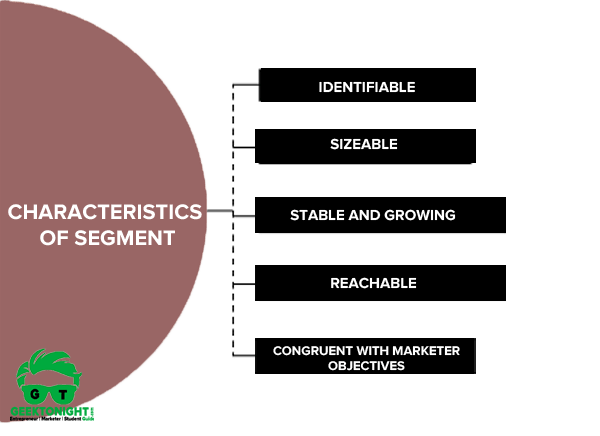
Identifiable
Marketers divide the market into exclusive segments on the basis of common need by using the demographic, lifestyle, and other factors. These factors are named as bases for segmentation.
For example, in demographic segmentation marketers use gender, age, ethnicity to segment the market.
Sizeable
A profitable segment should have enough number of consumers. A segment can be identifiable but may not be sizeable.
For example, marketer divides the market based on education and wish to target female consumer having PhD degree in a village setup. This segment is identifiable but may not sizeable in a particular territory.
Stable and growing
Marketers look for the segments those are stable and growing in nature.
For example, students are identifiable and sizeable segment for e-retailers. Marketers know that in India a number of the customer using e-retailing will grow very fast in the coming decade.
Reachable
A segment can be identifiable, sizeable and stable/growing, but if it is not reachable then it is not a target segment. Reachable means the ability of a marketer to communicate with customers effectively and economically.
Imagine a group of customer living in one of hill area of India has no access to media. In this case, marketers cannot reach to the customer effectively and economically. On the other side, If the customer is educated, it makes easy for marketers to reach out to the customers.
Congruent with marketer objective and resources
Marketers may not be willing to target each and every segment, even if the segments qualify preceding criteria.
For example, Earlier Mahindra did not consider Scooter segment as one of the target segment because it was not in congruence with the Mahindra’s objective. Now Mahindra changed its strategy and its marketing objectives, and launched Mahindra Gusto in Scooter segment.
Requirements for Effective Segmentation
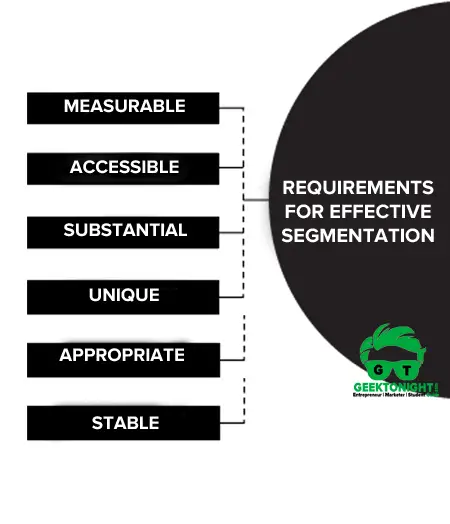
Measurable
Although in many consumer markets measurement is generally a relatively straightforward exercise, it is often a more difficult process with industrial or technical goods. This is due largely to the relative lack of specific published data.
Accessible
In some cases, it may be possible to identify a sizeable and potentially profitable segment but then, either because of a lack of finance or in-house expertise, this potential may be difficult to exploit.
Substantial
If the strategist is to justify the development of a segment, the exercise must be cost-effective. The size and value of the segment is, therefore, an important determinant of this decision. Size should, of course, be seen in relative rather than absolute terms, since what may be too small to be considered by one organization may be appropriate to another, smaller, company.
Unique
In its response, so that it can be distinguished from other market segments.
Appropriate
To the organization’s objectives and resources.
Stable
So that its behaviour in the future can be predicted with a sufficient degree of confidence.
Bases for Market Segmentation
The bases for market segmentation are as follows:
- Geographic Segmentation
- Demographic Segmentation
- Psychographic Segmentation
- Behavioural Segmentation
Geographical Segmentation
Geographical segmentation is one of the oldest and simplest methods of dividing the customer market on the basis of the geographical location of the customers.
For example, lifestyle products sell very well in big cities then in small towns. People living in rural and urban region of the country have different purchasing or buying habits. Therefore services or product has to be designed keeping in mind the different preferences of each customer group.
Demographic Segmentation
Demographic segmentation is dividing the customer market on the basis of several variables such as age, sex, gender, occupation, income, education, marital status, family life cycle, community, social status, nationality etc.
For example buying behavior of car, beauty products, mobile phones, cards, apparels, are hugely influenced by their demographics.
Psychographic Segmentation
Psychographic Segmentation is dividing the customer market on the basis personality, lifestyles, attitudes and habits of an individual. The personality refers to the traits which characterise persons as introvert, extrovert ambitious etc. Lifestyles refer to how a persons lives his life and do the expenditures.
For example person having a lavish lifestyle may consider having an air conditioner in every room as a need, whereas a person living in the same city but having a conservative lifestyle may consider it as a luxury.
Behavioral Segmentation
Behavioral Segmentation is dividing the market on the basis of the individual’s knowledge about the product and the usage of the product. The customer can be segmented into those who know about the product, those who don’t know about the product, Ex users, Potential users, Current Users First time users, etc.
For example, an athlete may prefer to buy running shoes to participate in marathon race and a non-athlete person may buy it just because he likes the shoes (light/medium user).
What is Targeting in Marketing?
The target segments are the groups of customers that the marketer decides to serve. It comprises buyers who share common needs, wants and preferences, and the marketer decides to serve them. The marketer would choose a segment that is viable; and, that he can cater to effectively and efficiently.
Targeting is to evaluate potential and commercial attractiveness of each segments and select one or more segments.
Targeting Approaches
Once identified, the organization needs to select its approach to target marketing it is going to adopt.
Four differing approaches can be considered.
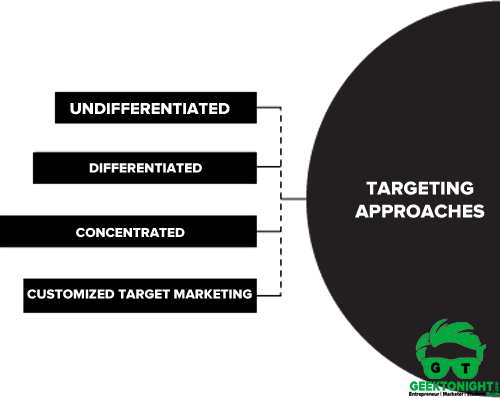
Undifferentiated
In an undifferentiated approach, there is no delineation between market segments, and instead, the market is viewed as one mass market with one marketing strategy for the entire market.
For example, the Olympics are marketed at a world market or certain government services. The UK postal service uses an undifferentiated marketing strategy, targeting everyone, although the Post Offices do differentiate between other products and services.
Differentiated
A differentiated targeting approach recognizes that there are several market segments to target, each being attractive to the marketing organization. As such, to exploit market segments, a marketing strategy is developed for each segment.
For example, Hewlett Packard has developed its product range and marketing strategy to target the following user segments of computing equipment: home officer users; small and medium businesses; large businesses; and health, education, and government departments.
Concentrated
A concentrated or niche-marketing strategy recognizes that there are segments in the market, but implements a concentrated strategy by focusing on just a few market segments. This is often adopted by firms that either has limited resources by which to fund their marketing strategy, or are adopting a very exclusive strategy in the market.
For example, Jordan’s cereal company originally used this approach to target just consumers interested in organic food products. This approach is also used a lot by small to medium and micro-sized organizations, given their limited resources: the local electrician.
Customized Target Marketing
The final approach is a customized targeting strategy in which a marketing strategy is developed for each customer as opposed to each market segment. This approach is more predominant in B2B markets (e.g. marketing research or advertising services) or consumer markets with high-value highly customized products (e.g. purchase of a custom-made car).
For example, a manufacturer of industrial electronics for assembly lines might target and customize its product differently from Nissan, Unilever, and Levi’s, given the differing requirements in assembly line processes for the manufacture of automobiles, foodstuffs, and clothing.
What is Positioning?
Product positioning is how the product is perceived by consumers based on the number of attributes in the minds of consumers relative to competing products.
Therefore, every company must be able to differentiate and determine the position of bids effectively to achieve competitive advantage during the life cycle of a product or an offer (Kotler et. al: 2003).
Positioning process has the following six steps:
- Defining the market in which product competes, identifying relevant buyers and competitors.
- Identification of key attributes of the products and understanding the perception of consumers for each attribute.
- Understanding the perception of consumers towards the competitor’s offerings on relevant attributes.
- Identifying the target consumers’ preferred combination of attributes.
- Developing the distinctive, differentiating, and value-based positioning and communicate each attribute provide the value.
- Creating a positioning statement focused on the benefits and value that the product provides and communicates with the target consumers.
Positioning Strategies
There are few types of positioning strategies used by the companies:
- Umbrella positioning
- Premier positioning
- Positioning against competition
- Un-owned positioning
- Repositioning
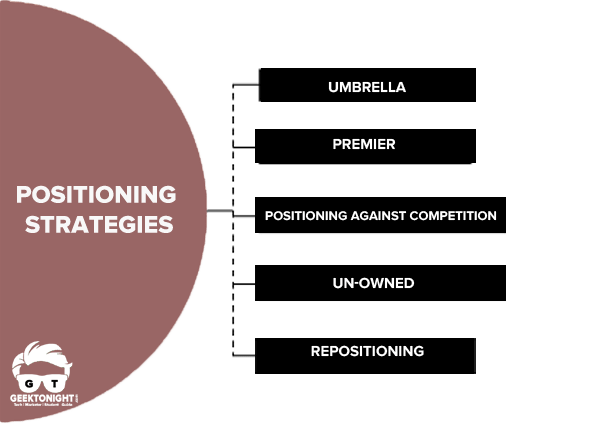
Umbrella positioning
Umbrella positioningUmbrella positioning is a statement that describes the universal benefits of the company’s offerings. In umbrella positioning, it do not offer the benefits of using a given product. It offers the benefits of using all the product from a particular brand.
For example: LG offers all its products with the positioning and punch line of “Life’s Goods”.
Premier positioning
It is one of the strategies exclusively focused on a particular brand, product or services.
For instance, TATA promotes its air conditioner with the exclusive brand VOLTAS but at the same time using the TATA brand.
Positioning against competition
In this strategy, companies acknowledge their competitors.
For example, AAJ TAK claims that they are India’s No 1 Hindi news channel.
Un-owned positioning
Positioning is the image in the mind of consumers; it is not a physical object that could be owned by anyone.
For instance, competitors in the market look for the positioning gap in the market and try to fill that gap, if found profitable.
Repositioning
Repositioning is the process by which a company strategically changes the distinct image and identity that its product or brand occupies in the mind of consumers.
For example, TATA positioned its NANO as LAKHTAKIYA (1 lakh) car but failed to create a proper consumer base due to its tag cheap car. Now TATA is positioning its product as “City’s car” and focus on driving and parking benefits of NANO in the crowded cities.
Perceptual Mapping
Perceptual mapping represents a geometric comparison of how competing products are perceived (Sinclair and Stalling, 1990).
Perceptual mapping is constructing a map like diagram representing consumers’ perception of competing brands along relevant product attributes.
It shows marketers:
- How consumer perceives their brand in relation to the competition.
- How to determine the direction for altering undesirable consumer perception of their brands.
- Gaps, in the form of un-owned perceptual positions, that represent opportunities for developing new brands or products.
For example, in fashion retailing, there are numerous brands in the marketplace all competing with each other across differing core attributes, brand reputation, store presence, price, and clothing quality or trendy and stylish.
To show how the different brands might be positioned relative to each other using the attribute scores for each brand of fashion retailer we can measure and map the brand positioning for the respective brands.
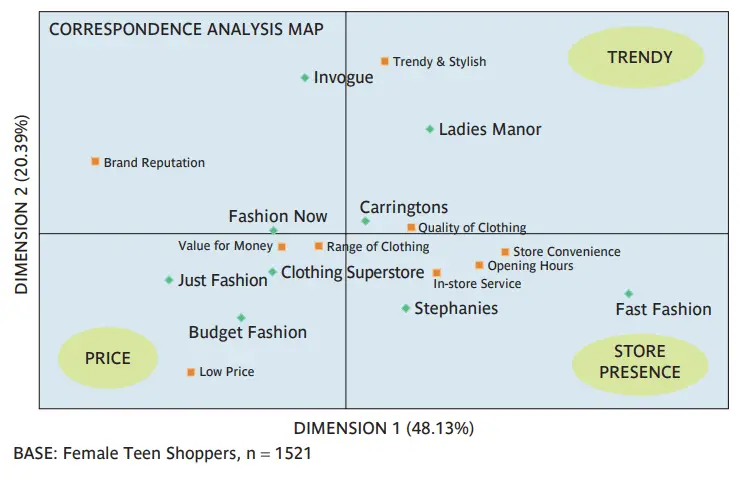
Key Terms
- Segmentation: Dividing the heterogeneous market into homogeneous segments by using one or more attributes.
- Targeting: Deciding the number of segments of the market to pursue.
- Positioning: Creating a distinctive image of product/brand in the mind of consumers.
- Re-positioning: Changing the existing image of band/product to new desired positioning.
- Perceptual mapping: Plotting the graph by using products/brand available with respect to the two most important attributes of products in the considered market.
Reference
- V. S. Ramaswamy, S. Namakumari; 2009; Marketing Management; MacMillan Publishers Pvt Ltd.
- Kotler P. and Keller, K. L. (2016). Marketing Management, 15th Edition, India: Pearson India Education Services Pvt Ltd.
- Schiffman, L. G., Wisenblit, J. and Kumar, S. R. (2016) Consumer Behavior, 11th Edition, India: Pearson India Education Services Pvt. Ltd.
- Belk, R. W., Bahn, K. D., and Mayer, R. N. (1982), ‘Developmental recognition of consumption symbolism’, Journal of Consumer Research, 9 (June), 4–17.
Marketing Management Topics
Go On, Share & Tell Us What You Think!
Did we miss something in Marketing Management Tutorial or You want something More? Come on! Tell us what you think about our post on Segmentation, Targeting and Positioning in the comments section and Share this post with your friends.
Marketing Management
(Click on Topic to Read)
- What Is Market Segmentation?
- What Is Marketing Mix?
- Marketing Concept
- Marketing Management Process
- What Is Marketing Environment?
- What Is Consumer Behaviour?
- Business Buyer Behaviour
- Demand Forecasting
- 7 Stages Of New Product Development
- Methods Of Pricing
- What Is Public Relations?
- What Is Marketing Management?
- What Is Sales Promotion?
- Types Of Sales Promotion
- Techniques Of Sales Promotion
- What Is Personal Selling?
- What Is Advertising?
- Market Entry Strategy
- What Is Marketing Planning?
- Segmentation Targeting And Positioning
- Brand Building Process
- Kotler Five Product Level Model
- Classification Of Products
- Types Of Logistics
- What Is Consumer Research?
- What Is DAGMAR?
- Consumer Behaviour Models
- What Is Green Marketing?
- What Is Electronic Commerce?
- Agricultural Cooperative Marketing
- What Is Marketing Control?
- What Is Marketing Communication?
- What Is Pricing?
- Models Of Communication
Sales Management
- What is Sales Management?
- Objectives of Sales Management
- Responsibilities and Skills of Sales Manager
- Theories of Personal Selling
- What is Sales Forecasting?
- Methods of Sales Forecasting
- Purpose of Sales Budgeting
- Methods of Sales Budgeting
- Types of Sales Budgeting
- Sales Budgeting Process
- What is Sales Quotas?
- What is Selling by Objectives (SBO)?
- What is Sales Organisation?
- Types of Sales Force Structure
- Recruiting and Selecting Sales Personnel
- Training and Development of Salesforce
- Compensating the Sales Force
- Time and Territory Management
- What Is Logistics?
- What Is Logistics System?
- Technologies in Logistics
- What Is Distribution Management?
- What Is Marketing Intermediaries?
- Conventional Distribution System
- Functions of Distribution Channels
- What is Channel Design?
- Types of Wholesalers and Retailers
- What is Vertical Marketing Systems?
Marketing Essentials
- What is Marketing?
- What is A BCG Matrix?
- 5 M'S Of Advertising
- What is Direct Marketing?
- Marketing Mix For Services
- What Market Intelligence System?
- What is Trade Union?
- What Is International Marketing?
- World Trade Organization (WTO)
- What is International Marketing Research?
- What is Exporting?
- What is Licensing?
- What is Franchising?
- What is Joint Venture?
- What is Turnkey Projects?
- What is Management Contracts?
- What is Foreign Direct Investment?
- Factors That Influence Entry Mode Choice In Foreign Markets
- What is Price Escalations?
- What is Transfer Pricing?
- Integrated Marketing Communication (IMC)
- What is Promotion Mix?
- Factors Affecting Promotion Mix
- Functions & Role Of Advertising
- What is Database Marketing?
- What is Advertising Budget?
- What is Advertising Agency?
- What is Market Intelligence?
- What is Industrial Marketing?
- What is Customer Value
Consumer Behaviour
- What is Consumer Behaviour?
- What Is Personality?
- What Is Perception?
- What Is Learning?
- What Is Attitude?
- What Is Motivation?
- Segmentation Targeting And Positioning
- What Is Consumer Research?
- Consumer Imagery
- Consumer Attitude Formation
- What Is Culture?
- Consumer Decision Making Process
- Consumer Behaviour Models
- Applications of Consumer Behaviour in Marketing
- Motivational Research
- Theoretical Approaches to Study of Consumer Behaviour
- Consumer Involvement
- Consumer Lifestyle
- Theories of Personality
- Outlet Selection
- Organizational Buying Behaviour
- Reference Groups
- Consumer Protection Act, 1986
- Diffusion of Innovation
- Opinion Leaders
Business Communication
- What is Business Communication?
- What is Communication?
- Types of Communication
- 7 C of Communication
- Barriers To Business Communication
- Oral Communication
- Types Of Non Verbal Communication
- What is Written Communication?
- What are Soft Skills?
- Interpersonal vs Intrapersonal communication
- Barriers to Communication
- Importance of Communication Skills
- Listening in Communication
- Causes of Miscommunication
- What is Johari Window?
- What is Presentation?
- Communication Styles
- Channels of Communication
- Hofstede’s Dimensions of Cultural Differences and Benett’s Stages of Intercultural Sensitivity
- Organisational Communication
- Horizontal Communication
- Grapevine Communication
- Downward Communication
- Verbal Communication Skills
- Upward Communication
- Flow of Communication
- What is Emotional Intelligence?
- What is Public Speaking?
- Upward vs Downward Communication
- Internal vs External Communication
- What is Group Discussion?
- What is Interview?
- What is Negotiation?
- What is Digital Communication?
- What is Letter Writing?
- Resume and Covering Letter
- What is Report Writing?
- What is Business Meeting?
- What is Public Relations?
Business Law
- What is Business Law?
- Indian Contract Act 1872
- Essential Elements of a Valid Contract
- Types of Contract
- What is Discharge of Contract?
- Performance of Contract
- Sales of Goods Act 1930
- Goods & Price: Contract of Sale
- Conditions and Warranties
- Doctrine of Caveat Emptor
- Transfer of Property
- Rights of Unpaid Seller
- Negotiable Instruments Act 1881
- Types of Negotiable Instruments
- Types of Endorsement
- What is Promissory Note?
- What is Cheque?
- What is Crossing of Cheque?
- What is Bill of Exchange?
- What is Offer?
- Limited Liability Partnership Act 2008
- Memorandum of Association
- Articles of Association
- What is Director?
- Trade Unions Act, 1926
- Industrial Disputes Act 1947
- Employee State Insurance Act 1948
- Payment of Wages Act 1936
- Payment of Bonus Act 1965
- Labour Law in India
Brand Management







